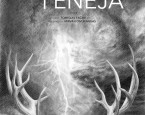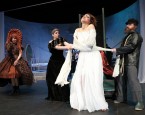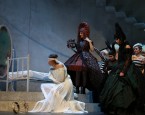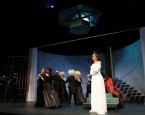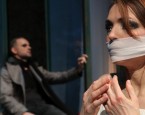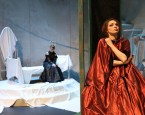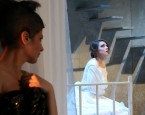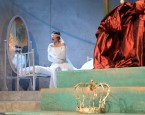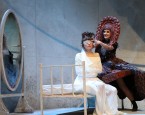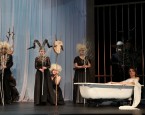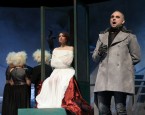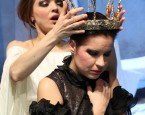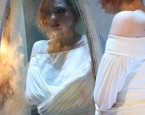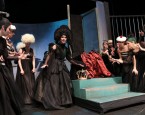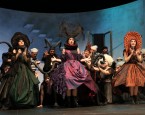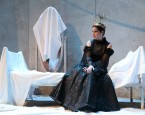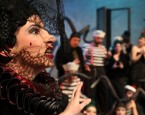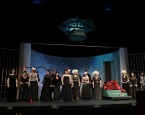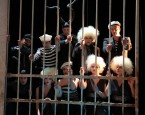
Premiere DIDO AND AENEASHenry Purcell
The director Mirva Koivukangas announces, “Dido and Aeneas by Henry Purcell and the librettist Nahum Tate is a Baroque opera recounting the unhappy love of Queen Dido and Prince Aeneas. Originally, the plot is set in the King’s palace in Carthage, however, in this direction, I’d like to leave the location open. Rather than in the physical space, I’m interested in the landscapes of the mind, especially as their interference influences the man’s experience of reality. In which point is it, on the border between truth and imagination, that they mingle and disappear, when is it that phantasy takes place of the truth in the man’s mind? For me this is the story of Dido’s nightmare situation where gods and witches can be both her relatives and characters from imagination, where the perception of the present and the past is left to the public to resolve.”
The opera Dido and Aeneas is based on Virgil’s epic poem The Aeneid. It is a love story of Dido, Queen of Carthage, and the Trojan prince Aeneas. I do not see it solely as a love story of two people who fall in love, but also a story about how is it that someone, in this case Dido, can fall in love despite her fears. And can she really?
There is an interesting contradiction between Purcell’s music and the story itself. If Dido is in love, why is it then that her music is so melancholic and sad at the beginning? Why does she never say she has feelings for Aeneas? Does it mean that she does not have them? Why does Aeneas sing of love and securing his kingdom in the same sentence? Are there any real feelings between them? What is the motivation of Aeneas in growing close with Dido? Is he only trying to secure his kingdom? These are the questions that were on my mind as soon as I started working on Dido and Aeneas.
All of us have fears. We are afraid to lose someone or something, afraid of each other, we are forging our own chains. There are many different struggles in our heads to be resolved in order for us to go on. It is these struggles that I am interested in. Dido is a queen that has been taken over completely by power, authority and responsibility. She is full of fears and chains, feeling ill at ease with herself. She sees threats everywhere, which is perplexing and driving her crazy. She is in a state in which truth and imagination mix. All of this has impact on her experience and understanding of people and situations.
The stage design, costumes and direction are filled with metaphors. When it comes to love, our hands and eyes are tied if we are too afraid. We need to open our mouth and speak in order to become free. It is through Dido’s eyes and her fears that we can see all situations in the direction of this opera. This is a story of the queen that has to free herself from all the nightmares as it is only when she is free that she is capable of loving Aeneas (or anyone else), a story of Dido who becomes complete and takes her place, not only as the queen of Carthage but also of her own mind and life. It is a matter of choosing the other side.
Mirva Koivukangas, director
Dido is a delicate and bitter coil full of secrets, presentiments and mirrors reflecting in each other. As any good art, it offers reading on a number of levels, as an epic on destiny, a story of duty and feelings, a story of conspiracy, as a political text that under the symbolism of a sketch from an ancient reading piece offers the lighting up of a complex political moment (fall of James II, Restoration and the supremacy of Anglican Church that made it legally impossible for the Catholics to rise to the throne and become part of the royal family)… and who knows what else.
Also, as any good art, Dido offers us the possibility to dive successfully into an intense, emotional and very concise drama without such heterogeneous contexts and layers.
Naturally, this is also the matter of your being open to the experience, as well as our art to fathom the architecture of the work.
At the formal level, in five scenes, by the unity of pulse and tonality, Purcell creates compact unities that proceed in a seamless and rhythmical alternation of spontaneous recitatives and chorus blocks, rounded out by instrumental preludes and dances. The motifs are highly recognisable, almost in a hit-making way; pregnant rhythm, the play of repeating syllables, discreet polyphony and a pictorialisation with a character, all ensuring a harmonious sequence of sound pictures that are quite alive. It is the extreme economy and practicality that are pivotal elements in the tonal architecture as well; the first act almost completely in C-minor (Dido’s languishment and relationship with Aeneas), namely, C-major (surrounding characters insisting on their uniting and presenting a brilliant future), with the exception of the chorus commentary (E-minor), which, in this way too, consolidates its role of the ancient chorus, addressing us from the tonality of F-minor (in the historical tuning, quite a problematic tonality)… and so on; the very catastrophe being set in the tonality centre of G-minor, where its place is in every real tragedy.
The number of characters is small, while their total separation enables one singer to play two characters (except for the leading role). The recitative is such a true copy of the speech, as if the composer had imbibed from the very sources of the Florentine Camerata; yet so skilfully imbued with arioso, as only Monteverdi was able to achieve. In short, wherever we look, we can see the dexterity of achieving a great deal with very little. Two chaconnes close the arch of the opera, the one from the beginning, in which Dido declares her languishment, and the final one, the famous Lamento, in which her languishment finds its tragic soothing and catharsis in the embrace of Thanatos.
This is where the significance of the multi-layered reading subsides, as does the whole background of mechanics of Purcell’s masterpiece, this pocket Venus of the Baroque opera repertoire. What remains is the experience of an absolutely superior and grand dignity of man, whose triumph over destiny is manifested in surrender and self-denial. Dido’s character radiates a much more masculine energy than the character of Aeneas, who leaves a somehow unmanly impression, not because he is submissive to Jupiter, destiny and higher order, but because of the absence of self-discipline.
You will not hear Dido pant out through tears the stereotype “Ne me quitte pas” (Do not leave me); in the ancient composure and courage of someone who does not know where she is going, but proceeds with the dedication worthy of the adventure of human life, telling us, ”Remember me, but, Ah (!), forget my destiny”.
Tomislav Fačini, conductor
HENRY PURCELL (1659 – 1695) is the greatest English composer of the three hundred long history of English music (until the emergence of contemporary composers led by Benjamin Britten). He was organist of the Chapel Royal and of Westminster Abbey. His opus includes works of sacred music, ceremonial secular music, theatre music and instrumental ones, comprising thus the history of English music as one of its most prominent figures. Schooled on French and Italian inspired models of his predecessors, he created a new type of opera, of a distinctive individual style, abandoning first of all the former spoken recitatives and replacing them with singing. Clear melody lines, harmonious sonority and surprising combinations characterise his composing. His music has not lost on its freshness owing to the deep immersion of orchestral accompaniment into the story. Just as Mozart, Purcell died in his mid thirties, when he was only thirty-six years old.
Henry Purcell was at the peak of his career when he composed the opera Dido and Aeneas, while it was Nahum Tate with his libretto, based upon a theme from classical mythology, as it was customary in those times, who enabled Purcell to create and opera jewel of concentrated emotion. The opera Dido and Aeneas was premiered at the Josias Priest Girls School in London Chelsea in the year 1689. With this opera Purcell reached the highest degree of the early Baroque music scene. Dido and Aeneas is the most important English opera of the seventeenth century, while Purcell is the only early English composer of whose works the whole of English musical community is proud, having spread the fame of Purcell’s music through centuries, considering him to be the most capable and fruitful English composer. His genius in placing English language into musical art, the English have proudly proclaimed as unparalleled, also his presentation of human passions and tragedies of unsurpassable pathos and conciseness, particularly evident in Dido and Aeneas.
It might be surprising to know that Dido and Aeneas (1689) is officially the only opera of the author, celebrated as a great English Baroque composer and one of the greatest Baroque composers overall. In the years that followed, he composed semi-operas, works intended to be musical interpolations of a spoken drama. They were based on the synthesis of spoken, singing, dancing and instrumental parts, employing spectacular stage effects. This form was specific of the English musical practice of the late seventeenth century. Purcell wrote the music for Dioclesian (1690), King Arthur (1691), The Fairy Queen (a musical interpolation to one of the versions of Shakespeare’s play Midsummer Night’s Dream) (1692), Timon of Athens (1694), The Indian Queen (1695), etc.
Dido and Aeneas is the first production of Purcell’s opera in the Rijeka CNT!!
NAHUM TATE (1652 – 1715) was Irish poet, dramatist, librettist, translator and appointed poet of the English court. In the three short acts, his Dido is strong and emotional, fascinating in her sincere and simple deep inner turmoil well known to all. Midst lyric celebration, tragedy of characters and laments, the opera chorus takes up the role of the ancient chorus commenting the developments and advising individual characters. What is curious to note and definitely incomprehensible nowadays, is that at some time past, in the booklets and leaflets distributed prior to the performance, you could often find the note and apology for such a libretto, as Tate’s libretto used to be read with scorn. It was said that the dialogues were totally uninteresting and could not be read as poetry, but that they were suitable for a musical drama. Generally, critics considered him to be a mediocre writer, but never stopped to show interest for his works that always threw new light on the works he adapted or cooperated in their adaptation.
Nahum Tate is the author a great number of works. Apart from the libretto for the opera Dido and Aeneas, Tate is most famous for the adaptation of Shakespeare’s King Lear (in 1681, seventy-five years after Shakespeare’s King Lear, which “ruled” the theatres for 150 years. Again, it was for many years that the critics had a negative attitude towards this version, in which Tate adapted Shakespeare’s language and ending to the taste of the audience of those times, while the spectators adored him!

